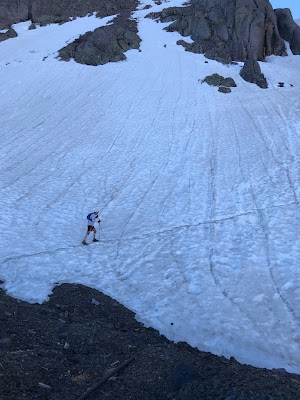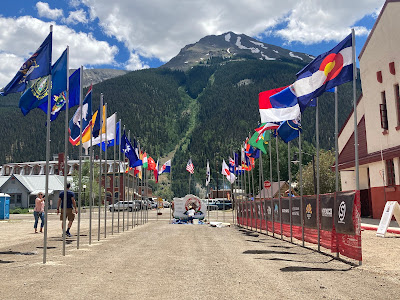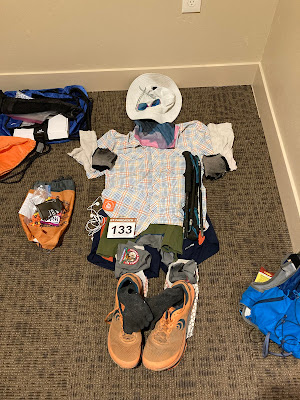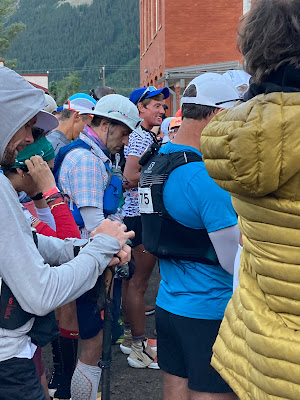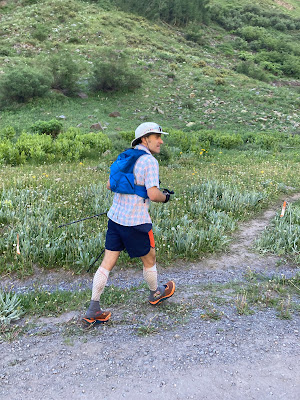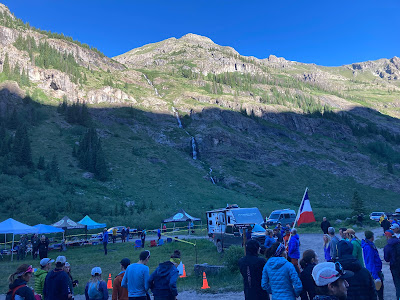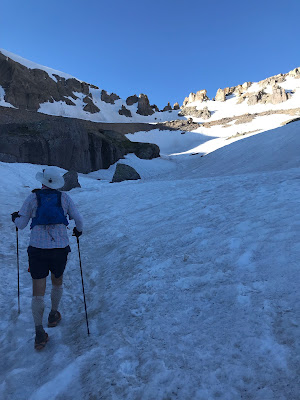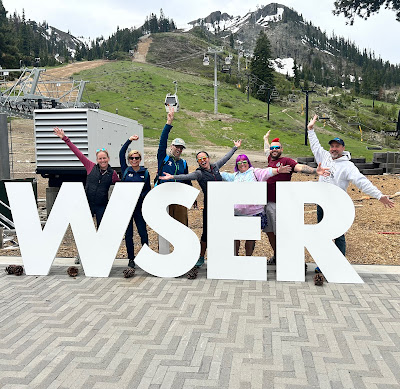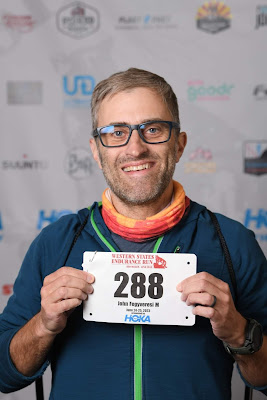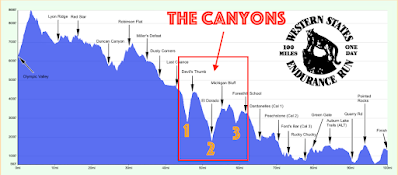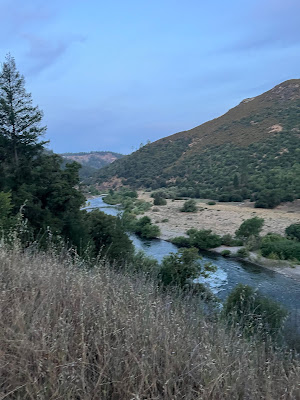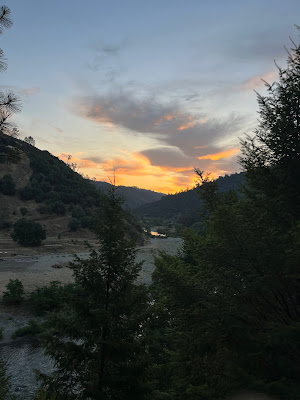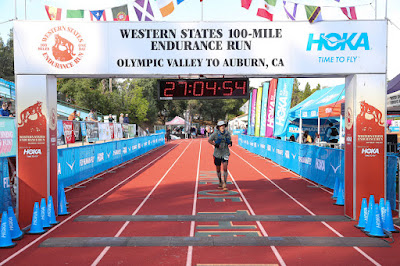Ascending to Kroger's Kanteen (Virginius Pass)
As a long distance runner and thru-hiker, there are many things that I foolishly take for granted. I assume that my legs will just turn over; I assume that my eyes will continue to see the trail in front of me; I assume that my lungs will continue to breathe in the air......
....And you see it's this last one that came at me and struck me down with such a fierce intensity, that I was not only unprepared for it...but I was truly terrified by it. Not being able to breathe....is a horrific feeling. I have a new-found empathy for the millions around the world with limited lung function...particularly those with asthma, long covid, emphysema, or other debilitating diseases. Never in my life have I felt like I was drowning....while out of the water, but that is the best way I can describe what transpired during the second-half of my Hardrock Run this year.
The good news, is that I sit here today (about 5 days later), and my breathing is returning, and my fatigue subsiding. I did ultimately complete my loop around the San Juan's (much slower than in 2018), and am truly content that it is all behind me now.
The bad news, is that I suffered from acute exercise-induced asthma that was brought on by extended exposure to very-dry and dusty high-altitude air. This asthma (which I've never experienced before, including in 2018 at Hardrock), led to fluid build-up in my lungs - a type of pulmonary edema - which ultimately led to me gasping for air on every climb from mile 75 to the finish. I nearly passed out a dozen times, had continual tunnel vision, had to take several on-trail naps, and dry-heaved countless times due to coughing up fluid. The medics at mile 95 talked about pulling me, but I insisted I'd be ok given the course was all downhill from there.
I am lucky that it wasn't worse. I made some stupid decisions. BUT...I was also not alone. My friend and fellow Barkley finisher, Travis Wildeboer, paced me from mile 60 (Ouray) to the finish and knowing he was with me (and is an EMT), made me feel much safer. If I were alone, I very-likely would have dropped. I thought a lot about my partner C, and my family, and how there were many times I should have quit...and was worried they'd be so furious with me.
The takeaway from all of this for me is quite simple. I am getting old. I can't do the things I used to anymore, and I'm ok with that. I am also going to take a break from hammering out multiple big ultras back-to-back. Running will always be there for me, but it will necessarily have to ease back a bit.
As far as my future with Hardrock. I will say this: I have now done the course in both directions. This apparently makes me a "True Hardrocker". With that said, I think it may be time for me to step aside. I will likely continue to volunteer my time at an aid station, but I suspect my days of running the course are over. One of the things I realized while out on the course and struggling to breathe, was just how much fun I had with C and our doggo in the week leading up to the race. We explored all over the San Juans, camped in the Maroon Bells, and simply enjoyed our time together. I kept thinking about how much I just wanted to be back in my tent on the shores of Crater Lake in the Maroon Bells, goofing off with my doggo and cooking a silly freeze-dried meal on our camp stove. I think the next time I head to the San Juans, it will be for much less selfish reasons...and if I am to hike over Grant's Swamp Pass again to see that indescribable image of Island Lake come into view, it will be with my family...not as a runner in a race.
One last note before diving into the full report, is that I have to thank my partner C for all the she did for me, and continues to do for me every day. She drove to remote aid stations to crew for me, while also taking care of our dog. She cooked me fresh chili on the side of the road with a tiny camp stove, just so I'd have "real food", and she took care of everything after the race while I was a useless lump in the hotel room. I have never felt so selfish in my life as I did this past weekend. I am incredibly lucky and grateful to have you in my life C.
...And also Travis. I am sorry you had to wait so much for my slow ass...but I am eternally grateful that you were there with me during those terrifying moments when I was unable to breathe. Having you as a pacer and as a friend is worth more than you know.
I know, I know....enough with the sappy stuff right? On to the report...
Pre-Race Revelry
As with my 2018 running at Hardrock, C and I decided to treat my acceptance into the race as an excuse to have a mini-vacation to the San Juans. I always feel terribly guilty about "race-cations", but was hopeful we could truly enjoy ourselves without it being ALL about Hardrock. Back in February, I managed to snag a permit for a campsite at the wildly popular Maroon Bells....so we started with that on the calendar. Otherwise, it was an open agenda. Something we would be trying out on this multi-day trip for the first time, was that we would be bringing our dog with us. We wanted to see how she'd do in the big mountains...and with camping (spoiler alert....she maybe got a C+)
When we left Flagstaff, we had several days to fill before heading to the Maroon Bells. I suggested we head to the Lizard Head Wildnerness area as it offers high altitude along with areas that are not very popular. This meant we wouldn't have to contend with big crowds, or fight for campsites. So, on our first night, we headed to the Kilpacker trailhead for the Wilson and El Diente (14ers) Peaks. I had hiked these peaks back in 2018 from the same trailhead and remembered it being quite remote and quiet. Sure enough, when we rolled in, there were only two other cars camped at the trailhead. We set up our little camp just over 10,200 feet, and watched the sunset. We learned quickly that given the high snow year Colorado experienced, there were MONUMENTAL numbers of mosquitos to fight off. Needless to say we were both caked in DEET.
Our original plan the next day was to spend only one night at this site, but we enjoyed the solitude so much, we chose to just stay for two. The next day, rather than pack up our camp, we hiked up the Kilpacker Trail into the inner basin for Wilson and El Diente peaks...and had a picnic at about around 11,500 feet elevation. The rest of the day was all about taking it easy and tapering. We went back to our camp, and essentially veg'ed out the rest of the day, laying in our hammock, taking naps, and playing with the dog. It was glorious.
On the second morning, we did pack up early and starting making our way up towards the Aspen area. We wanted to set up our next camp so that we could pack up early in two days, and make it into the Maroon Bells before 8:00 am. Cars are not allowed to drive up after 8:00 am, and we had a parking pass....so absolutely could not be late.
What we found was a perfect little spot just beyond Independence Pass that sat at about 10,500 feet. It was truly a secret spot and we again had no neighbors. The next day we played around at the pass (12,000 feet), and even hiked up to a high point ridge just under 13,000 feet for our lunch break. We were spending a lot of time over 10,000 feet, and I wasn't noticing any effects. Living in Flagstaff has certainly helped me acclimate quicker to high altitude.
After two nights in our secret spot, we packed up very-early the second morning, drove through the wildly overpriced town of Aspen, and made it up into the Maroon Bells well before 8:00. We packed up our backpacks, leashed up the dog, and began the 2-mile hike up to our reserved campsite at Crater Lake. As soon as we crested the hill overlooking the lake, I knew precisely why the Maroon Bells are so popular. The views are simply indescribable...and some of the most beautiful of any mountain area in Colorado or the Rockies.
We had our camp set up by 8:00 am, and then I proceeded to selfishly get in one last training session before the race. While C relaxed and hung out at the camp, I immediately set out to summit Maroon Peak (my 54th 14er). Originally, I had planned to try at least two 14ers in the Bells, but after how the hike up Maroon Peak went, I opted to call it quits after just one.
The hike up Maroon Peak was arduous due to its continuous class 3 rating, but also due to abundant snow on the route. The final mile of the ascent up along the ridge is very-difficult class 3 (with a handful of class 4 pitches) and was painfully slow. It took me over 8 hours to complete the full out-n-back, all while C waited patiently for me at camp, worrying why it was taking me so long.
When I did finally get back from the successful summit, I apologized profusely, and vowed to not hike another peak. We spent the rest of the day, and half of the following day, just lounging around Crater Lake with the dog. Looking back, that second morning was probably my favorite part of the entire trip and it made me somewhat angry with myself for spending so much time summiting Maroon Peak, when I could have been spending more time simply lounging around the lake.
We hiked back down to our car after lunch and were fully loaded by early afternoon. Our plan for that evening was to drive as close to Silverton as possible, but also trying to still stay above 10,000 feet. We decided to aim for Red Mountain Pass (11,000), and see if we could find a stealth camp spot. Sure enough, just as we crested the pass we found small dirt road that lead to an isolated camp spot. We set up our kit, and were lounging back before dark, cooking a fantastic veggie stir fry. That night I woke with a terrible stomach ache and worried that I picked up a bug. But by morning, most of the discomfort had thankfully subsided.
We drove into Silverton, and our collective mindsets shifted entirely to that of Hardrock. We checked into our hotel, I sorted by drop bags, and I checked in officially as a runner (receiving my wrist-band). The following day, I attended all of the required runner briefings and mentally prepared for the 6:00 am start on Friday. The last thing I remember telling C was, "This race is one that truly scares me. It's just so damn hard".
The Run Report:
At 5:30 am on Friday, I checked in at the start line and waited nervously for the next 30 minutes for the run to start. I was full of anxiety given the course briefing I had received the following day. I knew there'd be a LOT of snow on the course, many difficult sections, and extremely hot/dry conditions (with no monsoon rains expected). Spending what would likely be two full days baking under a high-altitude sun is an awful thought for me. I much prefer overcast or rainy conditions (despite the risk of lightning).
The start/finish line
Checking in on race morning (5:30 am)
My gear set up...
At the start...
Deep in thought...just moments before the start
I hugged C, stood quietly for the final two minutes going through my routine, and then we were off! We trotted down the road for the first mile before moving into the woods on a couple miles of single track. I remembered going through these sections in the dark during my final miles in 2018, and it brought a smile to my face. Just 98 miles to go I thought! We eventually popped out onto a rough forest road, and began what would be a 4000+ foot climb up to the first pass (Little Giant). I was feeling good and fresh, and carefully pushed out a steady hiking pace of about 3 mph. I carried on several conversations with other runners and very quickly I was on the final 1000 foot climb on single track up to the pass. I was surprised at how quickly the first climb had gone and starting thinking that perhaps the course would be gentler than I remembered!
I crested the top at 13,000 feet feeling good and began an easy jog down the back side to the first aid station at Cunningham (Mile 9). Despite its proximity to town, C had agreed to drive over and cheer me on there since she wouldn't get to see me again until Animas Forks at mile 44 many hours later.
I made it to the aid station feeling great in about 2 hours and 45 minutes. I was doing well and was all smiles when I saw C. I filled my bottles quickly, put down some calories, walked up the road with her for a hundred yards, and then began the next climb out of the station (I spent less than 2 minutes at the aid station). I felt bad that I only got to spend time with C for a couple minutes, but we both knew it was early and I should bank as much time as I could.
Coming in to Cunningham all smiles
Leaving Cunningham...eating...
Starting up the 4000+ foot climb after Cunningham
Heading up the mountain...
View of the second climb up from Cunningham. I'm up there somewhere...
The sun had fully risen at this point, and it was already getting noticeably warmer. The climb up to Stony Pass was tough and quite drawn out. There were countless switchbacks and it eventually dawned on me that the climbs along the course were not going to be easy after all. I climbed for over two hours before finally topping out on Stony Pass. At this point in the run though, I was still climbing strongly, and able to keep a steady pace. There was no indication that I would have any sort of debilitating breathing issues later in the race.
There was a small crowd on top of the pass that cheered us on, lifting my spirits, and I made quick work down and up to the subsequent pass (the second highest point on the course). Within an hour I was descending to the Maggie Gulch aid station where I spent about five minutes resting and putting down some much needed calories. The next stretch (Pole Creek and Cataract Lake), while considerably more mild, was also quite long and would be tackled during the hottest part of the day.
From Maggie to Pole Creek, I moved well and had a genuine smile on my face. I was out on the Hardrock course, and far enough in that I felt like it was finally a reality. I was on cloud nine....soaking it in. I hit Pole Creek all smiles, gobbled up some food and worked my way around a reroute just after. It's important to note at this point that I had already crossed well over a dozen full creek/river crossings. My feet hadn't been consistently dry on the course since the first 2 miles.
The climb up to Cataract lake was a bit slow, but eventually I rolled over the top and dropped somewhat quickly down to the first major aid station at Sherman (Mile 30). At Sherman, there were dozens of runners sitting in the shade with cold/wet towels. It was brutally hot. I got a full shower of ice water and it was glorious. I ate a couple of freeze pops, and drank a full slushy gatorade. This was the most refreshing drink of the entire race. I rummaged through my drop bag and restocked as well.
Fully renewed, I left the aid knowing a monumental challenge loomed ahead: Handies Peak. I knew that the first several miles of this climb would be on a dirt road however, so it settled my mind some. Climbing a road is always easier than a steep single track. The problem was that given the time of day (mid afternoon), and that it was a Saturday, there were hundreds of dune-buggy style side-by-side vehicles constantly zipping by on the road, kicking up dust. I did my best to keep my buff over my face, but inhaling all of this dust was likely what initially triggered my acute asthma response.
I passed by the Burrows aid on the road and eventually peeled off onto trail that would ultimately head up to the Handies Summit over 14,000 feet. It was near the top of this climb that I first noticed mild breathing issues. In the final thousand feet before the summit, I was stopping much more frequently to catch my breath and take breaks. I just figured it was because of the altitude, but was also confused as I hadn't had any issues yet with elevation (or when I climbed Maroon a few days prior). I shrugged it off and did eventually top out on the summit about an hour before sunset.
Leaving Handies, I felt good knowing that I would never have to climb to these elevations again and the highest point was now behind me.
I made quick work down around the American Basin, filling up my water bottles on some fresh snow melt...and then topped out on the adjacent pass just as the sun was setting. I stopped briefly to admire, before plunging quickly down to Grouse Gulch. I knew C would be waiting at Animas Forks just up the road at mile 44 and I was eager to see her. I made it off the trail at Grouse (a few miles down-road from Animas), just as I had to switch on my headlamp. As I hiked up the road to Animas, I was again presented with dozens of crew vehicles driving by kicking up fresh dust. My headlamp really illuminated just how much dust I was truly inhaling into my lungs.
Less than 40 minutes later, and just after dark, I arrived at Animas to find C waiting for me, all set up with a chair, and with freshly cooked chili. I was noticeably tired and all I wanted to do was sit...but I knew I had a long night ahead of me climbing up and over Engineer Pass and down into Ouray. I spent about 10 minutes again putting down much-needed calories, and did take a long-overdue sitting break in our chair. It was magnificent. Eventually, after some cajoling, I waddled my way down to the station and informed them that I was heading out. C walked with me up the road until the designated crew area ended and we parted ways. I would be making the long road-climb up to Engineer Pass, and she would be driving back down the rough Animas Road to Silverton, and ultimately over to Ouray (our next crew meet-up).
The climb up to Engineer was actually moderately pleasant. The gradient was gradual, and I was always in sight of the final pass. I could see headlamps in front of me and therefore never panicked about how much climb was left. This also meant the climb went quickly and I was able to make really good time up the road. I was up and over the top in about an hour, and quickly making my way down to the Engineer aid station about 1000 feet below the pass on the other side. This is one of the aid stations that volunteers have to hike-in to, so I knew it would be somewhat spartan. The descent down was across open high-meadows, and proved difficult to navigate in places due to infrequent trail markings. I did eventually find my way on to the official trail, and was arriving at the aid station in less than an hour from the summit. I sat briefly at the station while I ate some warm ramen and hot cocoa, but didn't linger long for fear of catching a chill.
The descent from Engineer Aid down to Ouray is somewhat protracted, and I knew it would drag on. In addition, there is the section along the Bear Creek trail that weaves its way along a very narrow cut in the rock wall, giving way to a ridiculously precipitous drop off just to the left of the trail. I remembered hiking up this section in 2018 and being terrified of a misstep. This feeling was certainly present again as I weaved and twisted my way around the narrow trail. In the dark, there was no way to see the bottom of the drop-off either, making it appear like an endless chasm. It was legitimately terrifying.
After about two hours of fast-paced hiking, I did eventually find myself on the switchbacks that descend down to the highway outside of Ouray. I caught my first glimpses of town and thought, erroneously, that I was close. I had forgotten that once on the highway, it was still about 3+ miles of rolling trail before actually reaching town. This stretch of the course is probably my least favorite of the entire run...and many dub it the "pointless ups and downs" for good reason.
After nearly another hour, I finally found myself on the downtown roads of Ouray, approaching the aid station. Not only would I be seeing C again for a full crew stop, but, I'd be picking up my pacer (and fellow Barkley finisher), Travis.
I made it to the aid station after what seemed like an eternity and it felt good to just sit for a while. I ate whatever food C put in front of me and was content to just sit quietly for a bit. Travis joined in and it was genuinely good to see him. I warned him that I'd be slow, and he was content to go whatever pace I wanted. After about ten minutes of rest, we both loaded up and started up the long road out of Ouray and up to Virginius Pass. This stretch consists of over 8 miles of dirt road leading up to the pass, before the final 1000 feet on trails. Over the next few hours, Travis and I hiked at a brisk pace up the road and traded countless stories. We caught up on all sorts of topics and it was truly a wonderful stretch. I was still feeling really good, and by the time we neared the upper section of trail, it was already get light out. When we did eventually peel off the road for the final ascent to the pass, we were presented with enormous snow fields that were still quite frozen. This presented serious challenges both with navigation and with maintaining safe footing (I did not have any traction or micro-spikes with me). On one stretch, we had to use a fixed rope to haul ourselves up so as not to plummet over a hundred feet down the mountain side. As this was all happening, I began noticing that I was having some mild difficulty with my breathing. I again chalked it up to the elevation (nearly 13,000 feet), and pressed on with a few additional breaks leaning over my poles. Eventually we topped out on the pass and chatted with the folks at Kroger's Kanteen aid station (the highest aid station of any race in North America).
Tunnel just outside Ouray
Snowfield near Virginius Pass (I'm already gasping for air)
Final snow pitch up to Kroger's Canteen
Ascending a snowfield to Kroger's
Final pitch up to Kroger's (visible at the top)
On Virginius Pass...about to descend
Approaching Telluride
On the descent down from Virginius to Telluride, I again felt fine and we made great time. I found myself shuffling much of this descent and was pleased that I was able to move so well. By this point, I was still floating around a 40-42 hour expected finish time. The descent went quickly, and very soon we were on the final descent into Telluride (Mile ~75). This would be our last full crew stop with C on the course before the finish. I remember thinking how great I felt coming into Telluride and how there was only a measly 25 miles left in the race! Less than a marathon I thought!
But, it would be Telluride where I would last feel good....and most of the race thereafter was an absolute struggle.
Travis and me approaching Telluride aid station
Leaving Telluride....and feeling good for the last time.
We spent about 10 minutes in Telluride enjoying some well-earned snacks and when we left, I genuinely felt like we would crush the last 25 miles, but as we started the climb up to the first pass (Oscar's Pass), I started having much more acute breathing problems. There were moments when it felt as if I was going to pass out and I had to stop to suddenly gasp for air. I didn't understand what was happening to me, but it was terrifying. I felt like I was either drowning somehow, or that I was asphyxiating, despite having no issues up until that point. I had to stop every 50 feet of climb, to lean over my poles and gasp for air. I felt bad that Travis had to wait for me. At the pace I was moving, I told Travis it would likely take us hours to make the pass. He suggested a short trail nap, so I did my best to curl up and sleep under an alpine bush. It didn't help. When that failed, he mixed me up some high calorie maltodextrin mix and I gulped it all down (hoping it was maybe just a calorie and electrolyte imbalance)....but that didn't help either. Every bit of climb was torment and I couldn't go more than a few hundred feet before again stopping to prevent myself from passing out. This went on for hours as I slowly inched my way up to the saddle. It was simply awful.
After many hours, we finally reached the summit and I sat down for along while to simple rest at the cairn. I began panicking about the fact that we still had two large climbs left on the course before the finish and began doing the math. I had lost over 2 hours on the Oscar's climb and was now in serious danger of missing the 48-hour cutoff if things didn't improve.
Climbing to Oscar's Pass (This was my lowest point of the run)
We began the descent down to chapman and as we did, I noticed that I was coughing up thick phlegm. Every time that I did, I would gag and nearly vomit....but then I would notice I could breathe slightly easier again. This is when Travis noted a friend of his had similar symptoms on a multi-day climbing trip, and that the diagnosis was acute exercise-induced asthma...which led to phlegm and fluid build-up in his longs. Travis spent a few minutes hitting my back, and I coughed up enormous amounts of fluid...which gave me some noticeable temporary relief. I told him that I wanted to exploit that relief as long as I could so we shouldn't waste time climbing up to the next pass (Grant's Swamp Pass). We ate about 1500 calories each at Chapman and began the climb up to the pass. As we were climbing I noted that I was actually breathing better and was hoping it would last until the top, but as we were chatting, we missed a turn on the trail and spent about 20 minutes off course until we realized our mistake. This was monumentally frustrating given my condition.
Once back on the trail, we climbed quickly, gaining thousands of feet in just two miles. We made it to about 600 feet short of the pass when my breathing started becoming more labored again. At this point the course also climbs up an enormous scree and snow field up to the pass (probably the steepest pitch on the entire course). I struggled on the climb, making only a few steps at a time...resting between each mini push. It probably took me over 30 minutes to climb 500 feet. The final section of the pitch was on an incredibly steep snow field and I was so delirious I nearly lost my footing (which would have sent me tumbling down the mountainside).
On the top, we celebrated briefly and admired the views of Island Lake, before quickly beginning our descent down to the KT aid station. By this point in the race, my breathing was starting to become more labored even on easy descents.
We hiked our way into the KT station just as dusk was upon us, and we prepped for what would be our final climb up to Putnam Ridge. Just as we left the station, and forded a ridiculously fast-flowing and cold creek, my GPS watch ran out of battery. This was incredibly demoralizing as my watch was the only way I was tracking my elevation gain, and therefore my total climbing. I would now be climbing this final 3000 foot mountainside, completely blind, and in the dark. The thought of not-knowing how much climb I would have remaining, really upset me. I kept asking other runners that would pass us, "What does your altimeter say?"
On this final climb, my breathing troubles came back with a fierceness and no amount of coughing, would clear enough fluid to help. This climb would be like Oscar's.....slow and arduous. We inched our way up the mountain as the temperatures began to plummet. The trail was an endless trudge trough wet marshlands and my feet were constantly wet. It was all so miserable...plain and simple.
But then we topped out on the first part of the ridge, and I could see the headlamps in the distance going up and over the final ridgeline section. It was the first time I could positively see the final high point on the course, and it brought me an incredible sense of relief. I just had to get over that final climb, and it would be all downhill to the finish line. I felt a final kick of adrenaline and somehow, despite my breathing difficulties, I pushed up the final climb (gasping the entire time), until I topped out. For the first time in miles I actually pushed ahead of Travis and began moving well down to the final aid station. The temps were near-freezing up top as well, so I had a good excuse to move quickly to get back down into the trees and into warmer temps.
We made quick work of the upper descent and were at the final aid station within another 45 minutes. We refilled our bottles, drank some hot cocoa, and wolfed down some quick ramen. The medic at the station was concerned by my audible wheezing and considered pulling me, but I refused to let them. I told them I was much better on descents and even if they did pull me, I had to get down the mountain anyway....so I might as well just walk down myself to the finish. They agreed. Then Travis and I put our heads down, and forged ahead for the final 6 miles to the finish. We were told it was 4 miles downhill to the Mineral Creek river crossing (the deepest and fasting flowing on the entire course), and then 2 miles of rolling terrain to the finish (with some very-short climbs totaling a few hundred feet).
The four miles down to the river dragged on for quite some time, and I could feel myself fading terribly. I was falling asleep, gasping for air, and simply had trouble staying upright. I had to keep telling Travis to slow down as I couldn't physically keep up with him.
About an hour and twenty minutes after leaving the aid, we came up on the river...and it was a raging torrent. There was a rope tied up across, but the crossing would be ridiculous and incredibly dangerous. I gripped the rope as best I could and plunged in without thinking. The current was fierce and the water rose above my waist. It was frigid and I immediately began shivering. I as neared the far shore, I crossed through the roughest current, and was nearly pulled off of the rope. It was one of the most demanding crossing I've done since some of the more ridiculous crossings back in the Sierras during my PCT hike. It was all genuinely scary.
On the shore, C was there waiting. She had driven to the crossing to check on me and could tell that I was in horrible shape. She noticed my breathing immediately and told me to just take it easy over the last two miles. I thanked her for being there and then Travis and I pushed on to finish the final two miles. I was shivering horribly from the water crossing and just kept telling myself I only had 30 minutes left.
As we progressed down the trail, I became convinced that we got off course. It seemed like we were moving away from town and down a trail that was going on for way too long. I started becoming paranoid that we were never going to make it. Each time my anxiety peaked though, we'd finally see another trail marker and knew we were on course. This cycle repeated probably a dozen times over the next 20-30 minutes as we slowly made our way to the "Shrine" monument just up from town (the last marker before descending down to the finish line).
About a half-mile from the finish, the trail dumps you out on a dirt road that climbs up and away from town. It all seemed wrong and I was again convinced we were going the wrong way. It was a testament to just how badly I wanted it all to be over...and how delirious I was.
We finally reached the Shrine, and the trail veered off to the right and down into town. I knew it was just minutes to the finish now.
We trotted down the last dirt trail and C was there to meet us where it met the road in town. We all walked together to the final turn and as we approached the school, I picked up a feeble jog, gasping for air, and rounded the final turn to the finish chute. I ran up the chute, and then walked the final few steps up to the rock.
I leaned up against it, gave it a kiss (as is tradition), and then slumped into a chair. Given the late hour (~ 3 am) there were only a couple people outside to witness my finish. Dale (the race director) came out a few moments later to award me my buckle and I told him that I just wanted to get inside and lay down. I was in a bad place.
Completely spent and barely able to breathe....but finished.
I went inside and immediately talked to the medical team. I told them about my symptoms and they informed me that many runners were experiencing similar issues, likely due to the very-dry air and extended exposure to dust. There were many vehicles kicking up dust on the roads during the race, and with no rain, it only exacerbated the already dry conditions.
They measured my blood oxygen and it was 84 (It should be over 95). They immediately put me on supplementary oxygen and a nebulizer. I laid on a medical cot for about 30 minutes and waited until my oxygen levels came back up to normal. It was all a bit scary, but I was just so glad to be done and being taken care of. As I laid there, I remembered something Travis told me while we were on the last climb several miles back. He said, "There'll come a moment when you're all done with this, and you'll think...'I did it. It's done. I survived....and it's all behind me. Now I can rest.' As I thought about that, I drifted to sleep.
A short time later, C woke me up, I thanked the medical staff, and then we drove over to the motel. I spent a long time in the shower warming up, and then eventually went to bed. I drifted off, wheezing for air, but content to have completed the Hardrock course again....and in the harder direction. I was now a "True Hardrocker".
The next morning I attended the awards ceremony, where I was presented with my Hardrock Doctorate (2-time finisher). Afterward, C and I relaxed the rest of the day....eating enormous amounts of food, and simply doing....nothing. I was definitely grateful that I booked the motel for an extra recovery day.
Monday morning, we quickly packed, and finally checked out. On the drive back home, my breathing slowly began to improve. I thought about my final finish time of 44 hours and 55 minutes and was somewhat disappointed...but also grateful to have finished at all given my breathing issues. I had set out to complete the "Double" and my 100th ultramarathon....and I had. Mission accomplished. It was a good feeling.
I told C that my time on the Hardrock course had likely come to an end and that I wasn't planning to enter the lottery next year. But...then memories from my time on the course started to come flooding back, and as we crossed through Monument Valley and Navajo Nation....a slight grin could be seen on my face.....
A quick note about gear. I again wore my Topo Athletic Ultraventure 3 shoes....and they again were brilliant. These are probably my favorite trail shoes I've ever run in....so kudos to Topo for making such a great shoe. The Ultraventure 2 was a bit disappointing, so am thrilled that I've finally found a shoe that really does well (I wore the same pair for both Western States and Hardrock).
Second, I wore button-up Rabbit brand "High Country" shirts for both races, and also loved them! These are absolutely fantastic shirts....and now my go-to top for any outdoor adventure.
I again used my new Ultimate Direction Mountain Vest, and it performed well. There's a few quirks I don't like about it, but overall, I would say that I was pleased with it. One note here, is that I used 600 ml Nathan Bottles (as opposed to the 500 ml standard bottles). This allowed me a 200 more ml of fluids as well as less-concentrated drink mixes. I did carry a third empty bottle in my pack for the very-long stretches (which I only used once during the Handies stretch). I did run out of water briefly on the Oscar's climb.
I used my black diamond z-poles...and of course loved them. I had bought a pair of the leki ultra poles (the ones with the special integrated gloves), and just didn't like them (and returned them).
Nutrition was all over the place, but I did use a lot of the Tailwind "Naked" flavor, as well as Sword "Lemon" flavor.
I used Maurten Gels...they are expensive, but I never get sick of them, or gag on them. They are worth it in my opinion.
